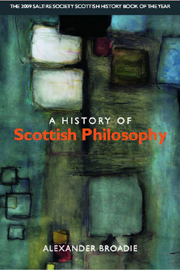Book contents
- Frontmatter
- Contents
- Acknowledgements
- 1 Introduction
- 2 John Duns Scotus
- 3 The Fifteenth Century
- 4 The Circle of John Mair
- 5 Humanism and After
- 6 Scotland Moves into the Age of Enlightenment
- 7 David Hume
- 8 Adam Smith
- 9 The Scottish School of Common Sense Philosophy
- 10 The Nineteenth Century: Ferrier to Seth
- 11 Realism and Idealism: Some Twentieth-century Narratives
- 12 Conclusion
- Bibliography
- Index
10 - The Nineteenth Century: Ferrier to Seth
Published online by Cambridge University Press: 12 September 2012
- Frontmatter
- Contents
- Acknowledgements
- 1 Introduction
- 2 John Duns Scotus
- 3 The Fifteenth Century
- 4 The Circle of John Mair
- 5 Humanism and After
- 6 Scotland Moves into the Age of Enlightenment
- 7 David Hume
- 8 Adam Smith
- 9 The Scottish School of Common Sense Philosophy
- 10 The Nineteenth Century: Ferrier to Seth
- 11 Realism and Idealism: Some Twentieth-century Narratives
- 12 Conclusion
- Bibliography
- Index
Summary
Section 1: What became of the Scottish Enlightenment?
Scottish philosophy of the eighteenth century and the earlier part of the nineteenth, the period covered by the Scottish Enlightenment, is an extraordinary success story, as is demonstrated by the international impact of its chief participants. The philosophy of Thomas Reid is one of the most significant of Scotland's invisible exports, and no less can be said of David Hume's philosophy. Political economy, represented especially by Adam Smith and Sir James Steuart, and historiography, represented especially by Hume and William Robertson, were also major fields. There is too the work of Scotland's scientists, among them Joseph Black, who discovered carbon dioxide (what he termed ‘fixed air’) and the phenomena of latent heat and specific heat; James Hutton, whose Theory of the Earth (1795) transformed geology, providing the science with the firm foundation on which it has since rested; John Robison, the discoverer of the inverse square law of electric force; and William Cullen, who made significant advances in the field of medical science, as did Alexander Munro II, who engaged in significant research into the nervous system. In engineering, James Watt, a close colleague of Joseph Black's at Glasgow, invented the improved version of the Newcomen steam engine that in due course was to be a major driving force of the industrial revolution. And in mathematics there are Colin Maclaurin, John Stewart and Robert Simson. The point is clear: across a wide range of disciplines the Scottish Enlightenment was a stunning intellectual performance that set the intellectual agenda for many people inside and outside Scotland for many decades thereafter.
- Type
- Chapter
- Information
- A History of Scottish Philosophy , pp. 301 - 323Publisher: Edinburgh University PressPrint publication year: 2008



